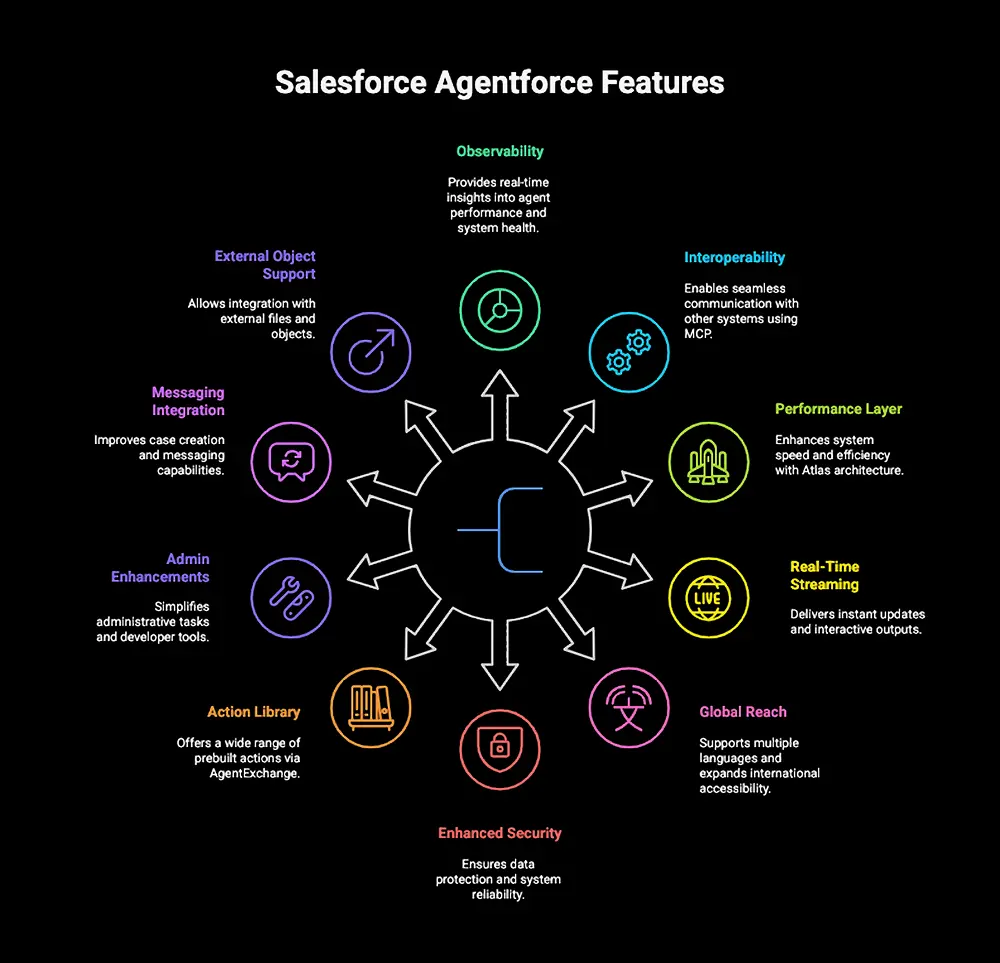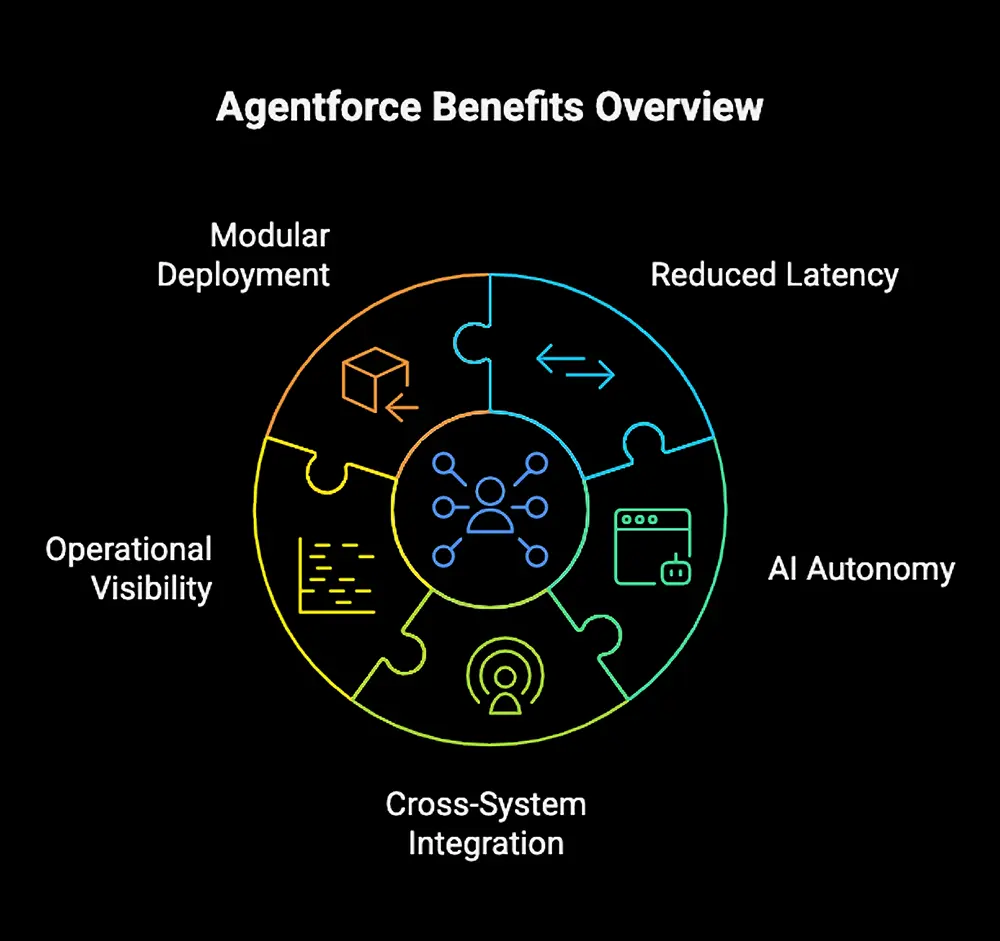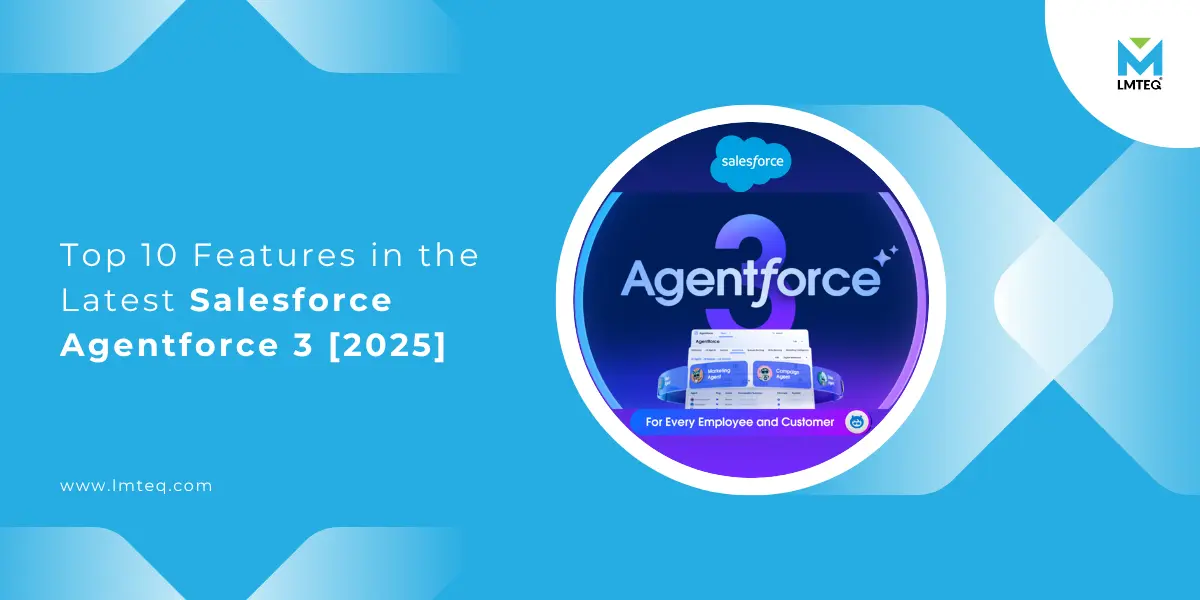In June 2025, Salesforce announced the launch of Salesforce Agentforce 3, a major upgrade to its agent productivity suite. With embedded AI and observability tools, the platform is now capable of managing complex, high-volume service workloads with minimal human intervention.
The announcement comes as Salesforce reports that AI is now handling over 50% of internal workloads, including customer service and support operations. This shift marks a significant step toward scalable, autonomous service delivery for enterprises.
For Salesforce Admins and business leaders, this blog offers a complete technical overview of Salesforce Agentforce, a breakdown of the Agentforce new features in version 3, and how these capabilities align with modern support challenges.
Understanding Salesforce Agentforce
Salesforce Agentforce is a modular, AI-enhanced platform designed to support agents across email, chat, phone, and digital channels. Integrated with Salesforce Service Cloud, it includes tools such as Agent Assist, macro automations, skill-based routing, and real-time CRM data integration.
Its goal is to provide guided workflows, automate repetitive tasks, and reduce resolution time. At the infrastructure level, it supports consistent deployment, high availability, and secure data handling. The platform is often deployed by enterprises with complex case management or compliance requirements.

1. Observability Through Command Center
2. Interoperability with Model Context Protocol (MCP)
MCP enables Agentforce 3 to interoperate with external systems via standardized agent interfaces. This allows for easy integration with vendors like PayPal, Stripe, and AWS, as well as support for industry-specific systems without custom development.
3. Atlas Architecture Performance Layer
Built on Salesforce’s Atlas architecture, Agentforce 3 now supports hosted large language models (LLMs), such as Google Gemini and Anthropic Claude.
This architecture improves context awareness and supports 200+ pre-configured workflows for domains like healthcare, telecom, and BFSI.
These Agentforce new features are designed to reduce latency, improve observability, and enable secure AI operations in regulated industries.
4. Real-Time Response Streaming & Rich Interactive Outputs
Agentforce 3 now supports streaming responses, letting agents see answers as they’re generated in real time, rather than waiting for full responses. It also introduces Rich Link Responses and Rich Choice Responses—interactive formats that enhance engagement during agent interactions.
5. Expanded Language Support & Global Reach
The new version is available in Canada, the UK, India, Japan, and Brazil, and fully supports six additional languages (French, Italian, German, Spanish, Japanese, Portuguese), with 30+ more on the horizon. This significantly broadens the capabilities of Salesforce Agentforce 3 in global deployments.
6. Enhanced Security, Verification & Fault Tolerance
- Automatic Model Failover: If a chosen AI model lags or fails, traffic seamlessly shifts to a backup, ensuring consistent performance.
- Prompt and Input Safety: Beta features include prompt-injection detection and filtering of toxic user content.
- Customer Verification Flow: Native support for OTP-based user verification enhances identity checks before agent engagement.
- FedRAMP High Compliance: Agentforce 3 is now approved for use in U.S. government environments via Government Cloud Plus.
7. Large Prebuilt Action Library via AgentExchange
AgentExchange now offers 200+ vertical-specific agent actions, using partner integrations with AWS, Google, PayPal, Stripe, WRITER, Box, Cisco, and more. This gives businesses out-of-the-box workflows for domains like healthcare scheduling, finance (transaction summaries, KYC), HR onboarding, and even Slack collaboration.
8. Admin & Developer Enhancements
- Prompt Builder & Accelerator Tools: Salesforce provides low-code tools for designing agents. Prompt Builder lets admins translate natural language into actions, while the Agentforce Accelerator auto-generates complete agent workflows from simple descriptions.
- Enhanced Testing Tools: A built-in Testing Center simulates high-volume agent workloads and also supports batch testing via CSV plus auto-generated test data, helping teams QA before production.
9. Improved Case Creation & Messaging Integration
- Autonomous Email Handling: Agentforce Service Agent now crafts tailored email replies, drawing on tracking, appointment info, tone adjustment, and context from Data Library.
- Enhanced Messaging Case Capture: A new “Create Case with Enhanced Data” action uses prompts to auto-generate case details from messaging interactions and attaches full chat transcripts.
10. File & External Object Support
- External Data Prompts & Rich File Support: Prompt Builder now supports external objects and multi-modal inputs like images and files, though AI-driven file parsing (e.g., OCR workflows) remains an area of ongoing development as reflected in customer feedback.
Key Agentforce 3 Benefits

The benefits of Agentforce 3 are structured around performance, accuracy, and operational efficiency:
- Reduced Latency – Atlas-backed infrastructure delivers 50% lower interaction latency compared to earlier versions.
- AI Autonomy – Agent Assist can now handle complete conversation flows in low-risk cases, enabling a higher autonomous resolution rate.
- Cross-System Integration – With MCP, Agentforce can execute tasks in third-party systems, reducing agent context switching.
- Operational Visibility – The Command Center provides detailed insights into every agent action, improving governance and SLA tracking.
- Modular Deployment – Enterprises can deploy only the required modules, case triage, routing, macro automation, etc., based on internal processes.
From a technical standpoint, these Agentforce 3 benefits are applicable to both centralized support centers and distributed teams operating across time zones or departments.
Agentforce vs Agentforce 3: What’s Changed?
| Capability | Salesforce Agentforce | Salesforce Agentforce 3 |
|---|---|---|
| Architecture | Core Service Cloud/td> | Atlas + Hosted LLMs |
| Integration Support | Native Salesforce only | MCP for third-party systems |
| Observability Tools | Limited logging | Real-time Command Center |
| AI Automation | Macro-based flows | Dynamic AI-powered orchestration |
| Industry Workflows | Manual setup | 200+ prebuilt workflows |
This table illustrates how the newer version provides deeper control, better performance, and extensibility through AI-powered Salesforce tools.
Role of AI in Salesforce Automation for Agents
In Salesforce automation for agents, AI plays a central role in reducing manual input, enabling case deflection, and improving time-to-resolution. Agentforce 3 uses embedded LLMs to:
- Predict and triage incoming cases
- Suggest next steps based on the case history
- Recommend relevant knowledge articles in real time
- Execute pre-approved workflows (e.g., refunds, upgrades)
These AI-driven capabilities are fully auditable through the Command Center. Salesforce also allows admins to configure agent behavior using low-code tools, aligning actions with business policies and governance requirements.
Use Case – BFSI Enterprise with 10,000+ Support Tickets/Month
A large Indian bank deployed Salesforce Agentforce 3 to manage its growing digital service volume. Within three months of go-live:
- Case resolution time dropped by 26%
- First-contact resolution improved by 39%
- Agent satisfaction scores increased due to fewer context switches
- SIEM integration (via MCP) ensured compliance with RBI audit trails
This use case highlights the value of Salesforce customer service tools when implemented with the observability and AI governance features unique to Agentforce 3.
Real-World Data from Salesforce
Recent stats from Salesforce and external news coverage show:
- Over 5,000 enterprises are now using Agentforce worldwide
- Agentforce handled 70% of all digital service interactions during the peak 2025 tax season for 1‑800Accountant
- Salesforce targets 1 billion autonomous agents to be operational by late 2025
- Agentforce 3 reduces response latency by up to 50% compared to prior versions
- Slack AI integration has grown 233% in 6 months, largely powered by Agentforce APIs
These numbers affirm that Salesforce Agentforce 3 is not just a software update—it is the infrastructure for AI-led service operations at scale.
Also Reads:
Conclusion
Salesforce Agentforce 3 is a substantial evolution of the Service Cloud platform. Its AI-native architecture, embedded governance, and modular design make it suitable for enterprises seeking measurable gains in service delivery. By introducing interoperability, enhanced observability, and AI performance optimization, Salesforce has repositioned Agentforce from a productivity tool into a core automation layer for service operations.
Implement Salesforce Agentforce 3 to build resilient, intelligent support systems with measurable ROI with LMTEQ. Contact Us
FAQs
1. What is Salesforce Agentforce used for?
It’s a toolset within Service Cloud designed to enhance agent efficiency through automation, AI suggestions, and integrated CRM workflows.
2. What are the top Agentforce 3 benefits?
They include faster case resolution, reduced latency, real-time observability, and seamless integration with third-party platforms.
3. How does Agentforce vs Agentforce 3 compare?
Agentforce 3 includes hosted LLMs, a Command Center dashboard, and third-party interoperability, which were not available in earlier versions.
4. What industries benefit most from Agentforce 3?
Industries with high ticket volumes and compliance requirements—such as BFSI, healthcare, telecom, and e-commerce—see the most value.
5. Is Agentforce 3 suitable for regulated environments?
Yes. It supports hosted models and audit trails, and works well with SIEM platforms to ensure compliance in regulated sectors.
